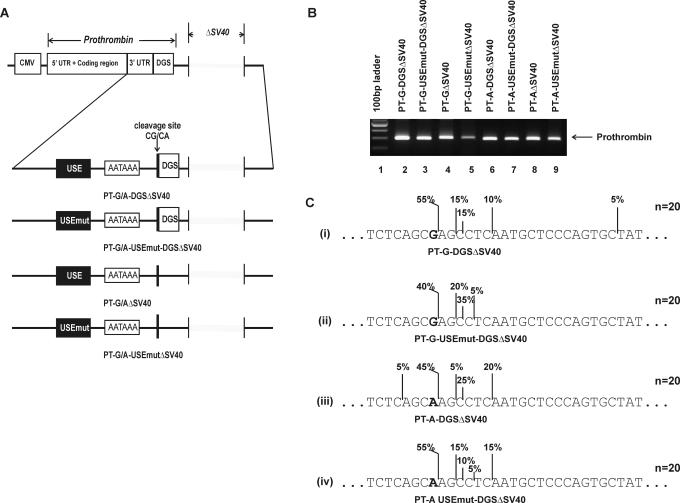Figure 6.
The prothrombin G20210A and the USE do not impact on cleavage site selection in the absence of competition. (A) Schematic representation of the constructs expressing prothrombin variants. All constructs express the full-length prothrombin cDNA including the entire 3′-UTR under the control of the CMV promoter. Cleavage and polyadenylation elements involved in prothrombin 3′-end formation are indicated: USE, upstream sequence element; DGS, 50 bp downstream genomic sequences; AAUAAA, polyadenylation signal; CG/CA, polymorphic cleavage site. The SV40 polyadenylation sequence has been removed from all constructs (ΔSV40): PT-G/A-DGS, prothrombin variant cDNA with 50 bp of DGS; PT-G/A-USEmut-DGS, prothrombin variant cDNA with 50 bp DSG and mutated USE; PT-G/A, allelic prothrombin cDNA with no DGS; PT-G/A-USEmut, prothrombin variant cDNA with mutated USE. (B) 3′RACE results of RNA prepared from HEK-293 cells transiently transfected with constructs expressing prothrombin allelic variants (with and without DGS and/USE) using vectors that had the SV40 polyadenylation sequence removed. Lane 1, 100 bp DNA ladder; lane 2, PT-G-DGS; lane 3, PT-G-USEmut-DGS; lane 4, PT-G; lane 5, PT-G-USEmut; lane 6, PT-A-DGS; lane 7, PT-A-USEmut-DGS; lane 8, PT-A and lane 9, PT-A-USEmut. These vectors generate a single 3′RACE product representing prothrombin mRNA being cleaved at its natural position. (C) Schematic representation of the percentage usage of prothrombin cleavage sites (determined by sequencing) generated by the above constructs; (i) PT-G-DGSΔSV40 (n = 20), (ii) PT-G-USEmut-DGS ΔSV40 (n = 20), (iii) PT-A-DGS ΔSV40 (n = 20) and (iv) PT-A-USEmut-DGS ΔSV40 (n = 20). The polymorphic residue at position 20210 is shown in bold.

